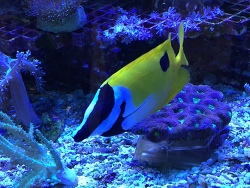Info
A typical representative of the rabbitfish that feeds predominantly on a vegetable diet. Like all rabbitfish relatively easy to maintain.
Usually lives in pairs, but this is unlikely to be considered because of the final size of the fish in the aquarium. In addition, the added specimens often do not get along at all and the newly introduced fish usually does not survive.
In general, aquariums under 1000 liters are only a stopgap solution. The fish becomes simply too fast too large like most fox faces. Whereby 20 cm are surely still better than 40 cm, which other foxfaces can reach. We do not recommend keeping them in small aquariums, because the fish needs a lot of space in any case.
You can never tell beforehand if he eats something specific or not. It is relatively certain that it eats filamentous algae, sometimes also spherical algae and sometimes even Bryopsis algae, sometimes vitaminized.
It can be distinguished from Siganus vulpinus by the additional clearly visible black spot.
In this species of fish, single or multiple fin rays are provided with spines that inject the toxin. The effect of the toxins can range from simple nausea to death of the injured person.
Catching and or handling in the aquarium with this fish species should be done with extreme caution.
Injuries to the keeper are very painful, but not fatal. The Poison Control Center in Munich classifies rabbitfish rather as less toxic.
Before buying a rabbitfish, please check if keeping it is allowed in your state.
You can find this information in the respective valid dangerous animal law of your federal state.
https://www.aspe-institut.de/downloads.php
Synonym:
Lo unimaculatus Evermann & Seale, 1907







 PEDE
PEDE








































